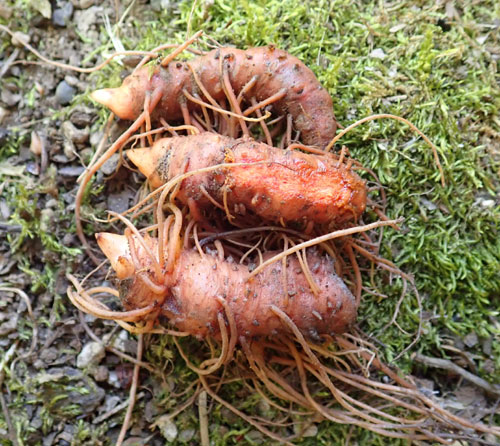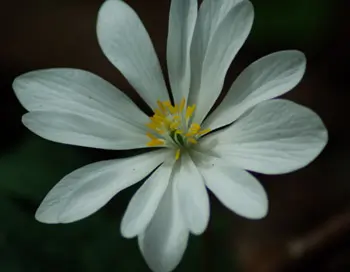Dormant live roots ordered now will ship fall of 2025
Bloodroot Live Root (Sanguinaria canadensis), organic
Price range: $7.00 through $35.00
Bloodroot–the early spring flowers are virgin white, arising from the blood red rhizomes prior to the unfurling of the fleshy, palmate leaves. When transplanting, place the rhizome at the soil surface, buried only about half way in, making sure the rootlets are covered with soil. Then cover with mulch. This is the most dependable way of getting the plant started in your shade garden—planting high reduces chances of rot. After several years the bloodroot will naturalize and self-seed, increasing greatly in size and producing much progeny. The sap of the plant, especially abundant in the rhizome (the root), is bright red and loaded with the alkaloid sanguinarine. Traditional use (TWM, Native American): expectorant and anticancer agent. Low-dose botanical. High demand in herb trade.
Planting Bloodroot Roots: Best to plant dormant live roots in the fall for emergence in the spring. May be planted in woodlands, shade garden or in pots. Prefers dappled sunlight over complete shade. Grows best in woodlands under the shade of hardwood trees, not conifers. Bloodroot is a bit funny about dirt–sometimes it likes a deep humusy soil, but other times it grows enthusiastically on top of limestone outcroppings, the rhizome covered in moss, rooting into rock, not soil. For all practical purposes, the roots may be planted in regular garden soil in shade garden or in regular forest soil in forest. No fertilizer or compost is needed. Rake away existing mulch and plant root on top of the mineral soil, tucking the rootlets into the soil, leaving the rhizome (the barrel-shaped part) half buried in soil, with the bud pointing straight up, and tamp in firmly. Then cover with mulch, about 2 inches in all. Regular forest mulch, rotted leaves, or coir work well. Commercial bark mulch is not a good choice. Plant roots between 6 inches to 1 foot apart. Water once after planting, after which winter rain and snowfall will keep them sufficiently watered. Bloodroot tends to rot, so be careful of overwatering, it is counterproductive. The roots will overwinter under the mulch and the plant will emerge and probably flower first thing in the early spring. If during the spring and summer the planting becomes very dry (ie no rain for 2 weeks) then it is a good idea to water them. That is all the care that is usually required. If potting up, use standard potting soil, three roots per gallon pot. Mulch on top of the pot and place in shade garden.
Live root, Certified Organically Grown
Please note: Available within USA only. Ships starting September through hard frost.











What others are saying
There are no contributions yet.